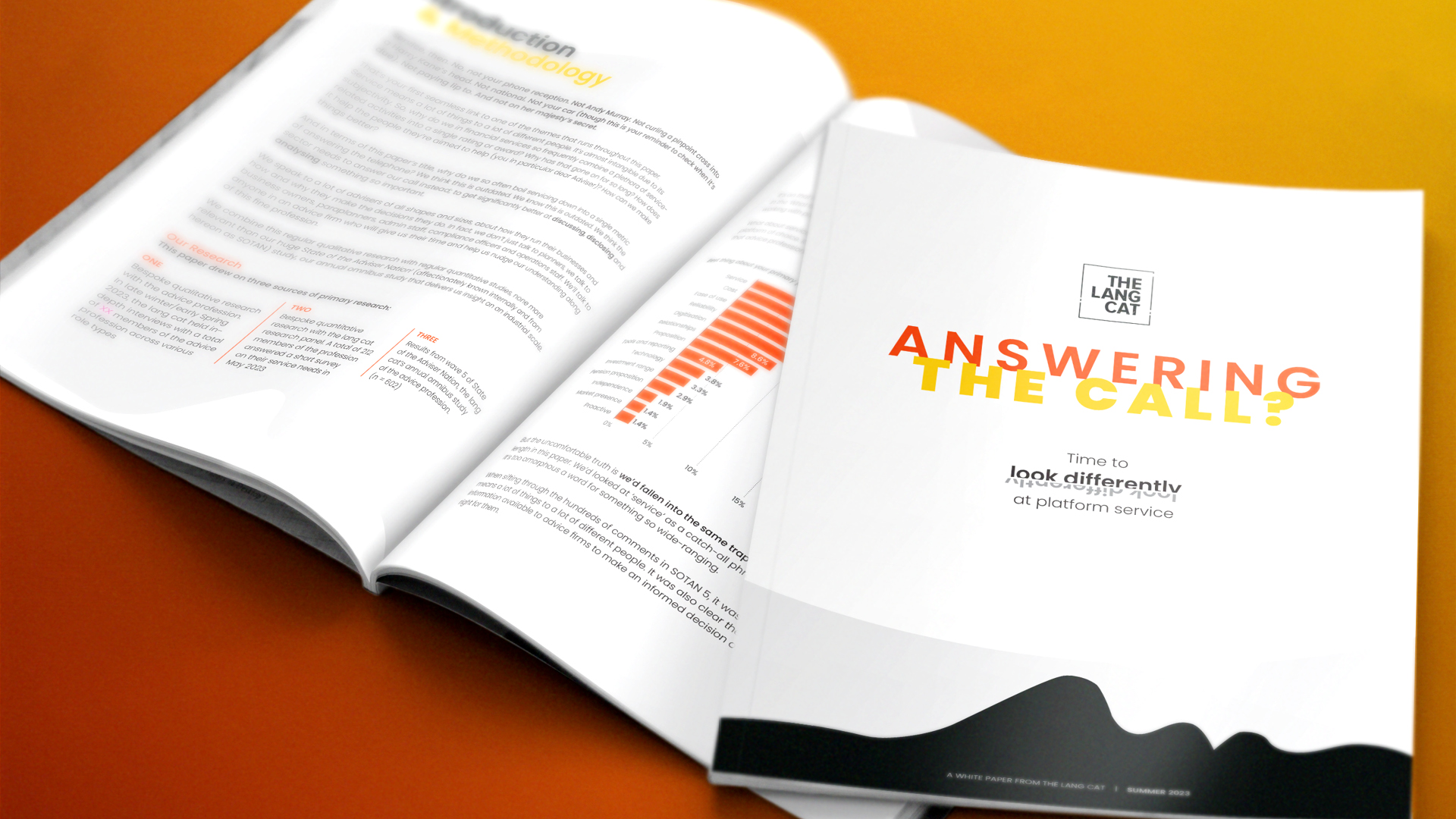There have been few things I’ve enjoyed more since joining the lang cat than buffing up our patented Recursive Pricing Engine (with integrated Turing Guessing Module). But it’s been a little quiet on the pricing front, so when I heard that Nucleus had trimmed its charges, I positively sprinted into work[1] to get my claws into it.
For those unfamiliar, Nucleus is an Edinburgh-based wrap platform which uses Bravura technology and outsources admin to Citi. It has about £6bn under administration, and declared it had moved into profitability earlier this year. It’s part-owned by advisers, with the rest taken by Sanlam (the South African financial giant) and staff.
Nucleus is on something of a roll. Fresh from those recent profitability announcements and its #leftbehind marketing campaign it now completes its triumvirate of positivity with a price-cut. Let’s look at the details of the new structure:
- Portfolios under £500k – 0.35%.
- Portfolios between £500k & £1million – 0.25%.
- Portfolios over £1million – 0.15%.
Nice and simple. But what’s that? Speak up. How does it compare to the old structure?
Well, those of you who take delight in memorising platform charging structures (oh, come on, who doesn’t?) will recall that Nucleus previously had a 5-tier structure starting at 35bps with 5 being lopped off at each £1 million milestone up to £5million. So, in practice this price cut means:
- Portfolios between £500k & £1million – a 10bps reduction.
- Portfolios between £1 million & £2 million – a whopping 15bps off.
- Portfolios between £2 million & £3 million – back to 10bps off.
- Portfolios between £3 million & £5 million – 5bps cheaper.
More initial reactions, this is a chunky reduction from previous levels. For example, a £1.5 million portfolio will now set clients back 0.25% rather than 0.32% in the old world. (Remember, the charges are tiered so the AMCs are applied accordingly across the portfolio
While this is a welcome reduction for rich people, let’s have a look at a comparison before getting too excited. We’re looking at SIPP wrappers here!
|
Portfolio size |
£100k |
£200k |
£500k |
£1m |
£1.5m |
£2m |
£5m |
|
New Nucleus |
0.35% |
0.35% |
0.35% |
0.30% |
0.25% |
0.22% |
0.18% |
|
Old Nucleus |
0.35% |
0.35% |
0.35% |
0.35% |
0.33% |
0.32% |
0.25% |
|
AJ Bell |
0.44% |
0.32% |
0.21% |
0.20% |
0.19% |
0.16% |
0.10% |
|
ATS IFO |
0.30% |
0.15% |
0.06% |
0.03% |
0.02% |
0.02% |
0.01% |
|
Ascentric |
0.38% |
0.32% |
0.28% |
0.26% |
0.21% |
0.18% |
0.13% |
|
Aviva |
0.36% |
0.36% |
0.30% |
0.28% |
0.27% |
0.26% |
0.26% |
|
Elevate 2013 |
0.32% |
0.32% |
0.28% |
0.28% |
0.28% |
0.28% |
0.28% |
|
Cofunds |
0.43% |
0.29% |
0.26% |
0.23% |
0.20% |
0.19% |
0.17% |
|
Skandia |
0.39% |
0.34% |
0.32% |
0.28% |
0.24% |
0.22% |
0.18% |
|
Standard Life |
0.60% |
0.60% |
0.55% |
0.45% |
0.38% |
0.35% |
0.29% |
A couple of notes, ATS IFO is Alliance Trust Saving,s inclusive fee option. For AJ Bell and Ascentric we,ve included some trading costs, for we are nothing if not fair.
So what do we learn? Standard Life is still comically expensive and fixed-fee renegade Alliance Trust remains at the other end of the scale. Putting those outliers aside, we can see that the new Nucleus structure brings it snuggling much more in line with the rest of the market with typically 5bps either way separating the pack on the higher end fund values. This table includes product and trading fees; but always worth noting that Nucleus has none of those on SIPP, including drawdown. You pays your money (or your clients do) and takes your choice.
And here,s how it looks for ISA/GIA:
|
Portfolio size |
£100k |
£200k |
£500k |
£1m |
£1.5m |
£2m |
£5m |
|
New Nucleus |
0.35% |
0.35% |
0.35% |
0.30% |
0.25% |
0.22% |
0.18% |
|
Old Nucleus |
0.35% |
0.35% |
0.35% |
0.35% |
0.33% |
0.32% |
0.25% |
|
AJ Bell |
0.23% |
0.22% |
0.21% |
0.20% |
0.19% |
0.16% |
0.10% |
|
ATS IFO |
0.12% |
0.06% |
0.02% |
0.01% |
0.01% |
0.01% |
0.01% |
|
Ascentric |
0.29% |
0.27% |
0.26% |
0.25% |
0.20% |
0.17% |
0.13% |
|
Aviva |
0.25% |
0.25% |
0.25% |
0.25% |
0.25% |
0.25% |
0.25% |
|
Elevate 2013 |
0.32% |
0.32% |
0.28% |
0.28% |
0.28% |
0.28% |
0.28% |
|
Cofunds |
0.33% |
0.30% |
0.26% |
0.22% |
0.20% |
0.18% |
0.16% |
|
RJIS |
0.33% |
0.33% |
0.33% |
0.33% |
0.33% |
0.33% |
0.33% |
|
Seven IM |
0.30% |
0.30% |
0.30% |
0.28% |
0.23% |
0.21% |
0.18% |
|
Skandia |
0.39% |
0.34% |
0.32% |
0.28% |
0.24% |
0.22% |
0.18% |
|
Standard Life |
0.40% |
0.38% |
0.32% |
0.27% |
0.23% |
0.21% |
0.17% |
Here things are a little less marked. For example, Raymond James new structure is obviously just a smidge cheaper, but includes all trading including securities. Aviva still undercuts Nucleus by a healthy 5-10bps at lower portfolio sizes, using the same underlying technology. And Cofunds now looks very aggressive for even relatively modest portfolios. Interestingly, Noo Noocleus and Skandia cost almost exactly the same. Well, they always have got along well!
Criticisms
You’ll notice from this blog that there’s an awful lot of references to ‘£1million this’ and ‘£2million that’ and less mention of more modest portfolio levels. The price cut only affects portfolio sizes of £500k plus, and while it feels slightly churlish to criticise in the context of an industry rife with unprofitability, we would still have liked to see a price cut kick in at a smaller pot-size; perhaps £250k. No-one said that Nucleus HQ was a hotbed of pinko pantywaist liberalism, but it’s hard to get too excited about a cut that makes genuinely wealthy people very slightly wealthier.
We’ll cut Nucleus some slack though as its profitability clearly shows that it’s au fait with a calculator. And this is obviously a shift within a targeted segment (like Transact’s recent cut), rather than a competitive re-assessment across the board. Such is life. The bombs never hit you when you’re down so low.
Good things
We liked the simplicity of the Nucleus structure before, what with the lack of dealing costs, minimal wrapper charges et al to remember. This takes it one step further, smushing 5 tiers into 3. In an age of complexification, this is a good thing. The price cut itself is pretty significant at higher portfolio sizes and will no doubt help Nucleus extend its reach in the wealth space. It does still feel a shade pricey (relative to competitors) at the highest of fund sizes but there will doubtless be deals to be done. There remain very limited additional wrapper charges and none on SIPP.
The best part of this move though, from our eyrie in the fine port of Leith, is that Nucleus has explicitly linked this move to recent profitability. This should give the market the sense that here is an organisation with clear direction, and one which knows what it is doing. Fancy that. And even millionaires need a hand now and again!




